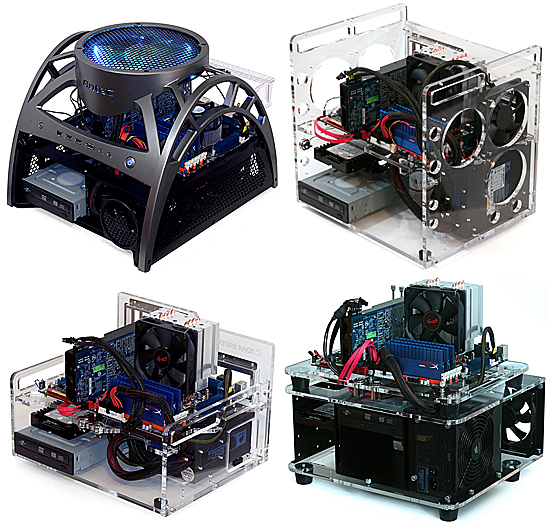Cage Match: Four Open-Air ATX Chassis
Better Than No Chassis At All?
The back rooms of PC shops and the most elite overclocking competitions generally don’t have much hardware in common, but perhaps the most similar component in both locations is the type of chassis chosen for motherboard testing: an open test bench, often with a phone book or empty box laid under the motherboard to allow the bottom tabs of graphics cards room to hang freely. Surely, a better way must exist.

Potentially more convenient chassis have been around for a long time, mostly in the form of metal frame structures that contain the parts that aren’t often changed, such as drives and power supplies, while easing access to the parts that are frequently changed, such as motherboards, RAM, processors, and expansion cards.
But perhaps that construction is going out of vogue. We even invited a well-known metal-frame type chassis manufacturer to participate, but were disappointed by the lack of response.
Our continued search revealed several options with more visual appeal. Today, we balance the design strengths and weaknesses of each model to determine its most appropriate market.
Get Tom's Hardware's best news and in-depth reviews, straight to your inbox.
-
johnny_5 When I had a desktop I would just leave the door off. It was unfortunately fairly noisy, but these would suffer the same problem anyways.Reply -
kikireeki I though the point of having an open-air Chassis is to be simple and fast but these are far-cry from that! very cool nevertheless.Reply -
Crashman kikireekiI though the point of having an open-air Chassis is to be simple and fast but these are far-cry from that! very cool nevertheless.Reply
I'm using the Torture Rack 2 right now to test several motherboards, I've added two push-through standoffs to keep them in place without screws. -
Onus Have you done any EMF testing on these? It seems to me that could be a considerable con on any of them.Reply -
thackstonns I wanted the Banchetto 101, but found a skeleton for 100bucks new. A friend won it in a land contest and didnt want it. So I went with that. It is a good case the only thing that really pisses me off is I have to unplug all the front panel stuff to slide the tray out. Also I am building a bench for it to set on out of acrylic to house my radiators and pump. I cant figure out a good way to run the cpu waterblock though. The top cage does come off with 4 screws, But I have looked everywhere and cant find thumb screws that fit. Otherwise I would just use that instead of sliding it in and out.Reply -
dragonsprayer whats wrong with a table or desktop with mobo box and antistatic plastin? works great less hassle! here is a photo from years and years ago! best desk to set up is martin lab testing set up (photo of martin lab persmission given to copy his stuff) - this is the s$#t!: http://s63.photobucket.com/albums/h138/4rothrocks/?action=view¤t=Worklog15.jpgReply -
dragonsprayer part 2: we build every system on a mobo box with anti static, we burn in the cpu/psu/mob/gou at max oc in the bios for 24-72 hours - i.e. 920 is burned in at 4-4.4ghz air cooled. we have done this since 2003. then hard drives are hooked up and the system programed. this even done for water cooling built with air cooler then converted to water. The gpu, mobo, psu, cpu and hard drives are tested then installed in the case. The system is then run on orthos and 3dmark loops and other tests for up to 7 days. So the mobo box, anti static works great - stick hdd on there bags, use the mobo box from the system.Reply -
duolc I use a Skeleton for my Case. Dust is an issue but a quick shot of air here and there and I can keep it under control.Reply
I Use an Asus Silent Knight CPU Cooler And It did not fit originally. I had to shave off one of the supports to make it fit.
